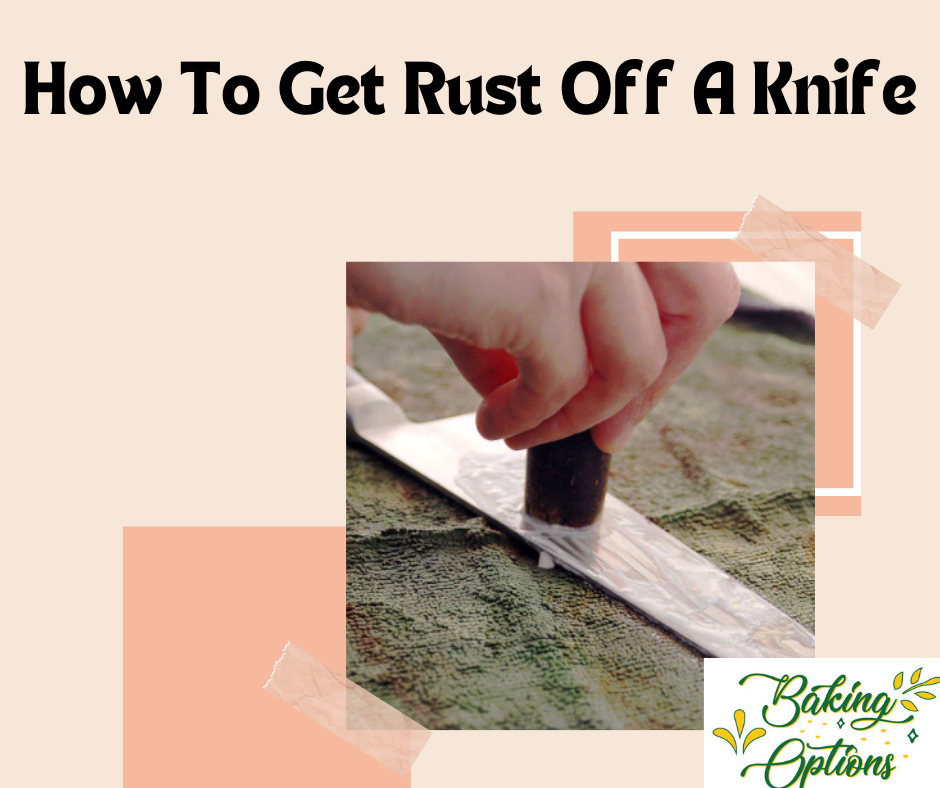What if you have a favorite old knife, and the blade is covered in rust when you find it? You usually throw it away at that point because there’s no option. But from now on, don’t do that because I will tell you an easy method to get rust off a knife.
In fact, I won’t share one method; I will share different methods so that you can choose whatever you feel is suitable. And I’ve done the research myself; these methods are things I’ve personally tried, with some on my knives and others on my friends’ knives.
Contents
What Causes Rusk Spots on Knives?
Rust in knives mainly results from a chemical compound called iron, oxygen, and moisture. Living in a humid climate or near the sea, you must be aware that moisture increases the chances of rusting.
You may ask about your ‘stainless steel knives,’ but I regret to inform you that stainless steel is also not corrosion-resistant.
Yet, stainless steel has iron in it, so it can rust if exposed to some conditions. Even if you use a knife that has a chromium concentration, there is a likelihood that the knife will develop a rust problem, as seen in the case of the Spyderco Salt Knife Series.
Even a tiny amount of water left on the knife after washing or slicing will immediately cause rust if not wiped off properly.
At first, they may look only like tiny rust spots, but left untreated, they will spread rapidly. Arranging your knives in a humid area or contacting other tools with rust issues will only worsen the problem.
Is Rust On A Knife Dangerous For Health?
No, rust is not poisonous in any way. This rust develops when exposed to moisture for an unlikely time, resulting from iron oxidation. Although it is possible to cut food with rusty knives or consume water from a rusty teapot without seriously risking your health, the only problem is that your food will taste metallic.
That’s why rust becomes dangerous, especially when the blade is in contact with the soil; however, there is no health concern if the knives are well stored. Therefore, although you should wash off the rust for better taste and sharpness, using knives with rust is pretty safe!
Method 1: With Baking soda
I always ensure that everything is affordable and provides the best results. I am discussing this method at the top because everything required is usually available at home.
Supplies Required For it
- Clean water
- Baking soda
- An old toothbrush
- A pot scrubbing pad or steel wool (for tougher rust cases)
So let’s start.
Tips Before Starting The Process
Baking soda dissolves the rust; no solid sign of rust is left. It can be safe if you do not allow it to come into contact with your eyes. When you have all your material, follow the steps below, especially if it is your first try. Ensure that the steel is not scrubbed with steel wool directly on its cutting edge.
Steps Include
- Prepare Paste
- Apply Paste
- Scrub Away The Rust
- Remove Stubborn Rust
Step-By-Step Instructions
- First, put into a mixing bowl as much baking soda as necessary for this next step. Add more clean, room-temperature water while stirring the mixture with a spoon or fork. Stir until it comes out thick, but not as thick as play dough or as thin as milk.
- When you have reached a paste that you like the texture of, spread it liberally on the protruding rusted parts of the knife. Make sure that the paste touches all the tiny pores of the knife affected by rust because it might appear again soon after the process.
- An old toothbrush is enough for mild to moderate rust and will suffice the planned goal—Circle small circles around those areas by rubbing them until the rust comes off the knife. Take a few minutes on this step, and do not be afraid to reapply the paste where the rust still exists.
- If some areas are still gritty, switch to a green plastic pot scrubber or the scrubbing surface of a sponge. When treating incredibly stubborn rust, you can use steel wool, but I recommend not applying pressure to the piece or coming into contact with the cutting edge to prevent the risk to the knife’s finish and sharpness.
Lemon & Salt Method
This method is very natural; both lemon and salt are natural ingredients. When these two are combined, they effectively remove rust stains due to their acidity, which is why this method is my favorite. My knife had some rust, so I used this method and got a better response. I learned this method from 5-minute craft videos, and trust me, it solves your issue in less than 5 minutes.
What You Need For it
- 1/2 Fresh Lemon
- Kosher Salt (or any type of salt)
- A damp sponge
Safety Tips Before Staring Process
Always handle the knife carefully, even if it is rusty because it can still cut. Safety should always come first. Choose a flat-cut surface; this advice applies to any rusty knife. This is important to reduce the chances of slipping. If you experience irritation from lemon juice, I recommend using gloves.
Steps Include
- Rub the Lemon on the Blade
- Scrub with Sponge
- Use Salt & Lemon
- Wash Knife
- Rinse & Dry
Step-By-Step Instructions
- Mash the lemon & take half of this lemon. Touch the rusty areas of the knife blade with the cut side. If the primer is rusty, remember to cover both sides.
- After applying lemon juice, it is time to take a lemon half in your hand and grab a wet sponge. Please wash the knife blade while polishing it and apply pressure to remove rust.
- Take some salt on a small plate and sprinkle a little quantity. Rub the cut side of the lemon half in the salt to ensure it sticks to the surface. Afterward, rub the affected rusty portion of the blade using the surface of the salted lemon half until you realize that the salt has melted.
- It is time to get the knife wet, so wash it under cool water to clear out the lemon juice and salt you used earlier. Cut the blade gently with a soapy washcloth, and clean with cold water once more.
- Lastly, remove the knife and rinse it once under cold water to wash away any traces of rust and soap. Wipe it dry gently using a cloth with no particles that might scratch the blade. Applying a thin layer of vegetable oil to cooking knives and machine oil to pocket or hunting knives for extra protection is recommended to prevent rust formation.
Sand & Pray Method
This method has impressed me a lot; you can remove heavy rust with a simple method, and it is possible with this method. However, you must remember the safety measures and follow the step-by-step process. First, let’s see exactly what we need for this.
What You Will Need
- 400-grit sandpaper
- A vice or a stable work surface
- Safety goggles (optional but recommended)
Safety Measurements
You should always use gloves while doing this because rust particles can get into your eyes. Also, keep in mind to keep sandpaper away from cutting edges; this way, the knife’s blade doesn’t get damaged or dull. I want to clarify that rust does not affect the blade. Some people say rust ruins the blade, but that’s not true. There can be mistakes when removing rust that can affect the blade.
Steps Included
- Secure Knife
- Use 400-Grit Sandpaper
- Check process
- Avoid Coarse Sandpaper
- Cleaning
Step-By-Step Instructions
- Place the knife in a vice or on a stable table with it firmly seated. That way, you’ll be able to work safely without worrying about a loose knife or a piece slipping out.
- Place your 400-grit sandpaper over the rusted regions of the knife blade. Proceed to rub on the affected spots using small circles. You’ll need some serious elbow grease since this takes some time.
- Stop every so often to inspect your work. You should be able to see clean, bright steel beginning to appear as you sand away the rust. If you still see rust, keep grinding until it is all gone.
- Be careful not to use too coarse sandpaper, as this can damage the finish of your blade. To get rid of rust without breaking the knife, use 400 grit.
- Once you’ve finished sanding and have removed all visible rust, wipe down the blade with a clean cloth to remove any dust or debris. For added protection against future rust, consider applying a light coat of oil.
Final Words
It’s clear how to get the rust off a knife, whether a mind rust or aur knie covered with rust. Trust me, these methods are effective. If you have a rusty knife, you should try one. And please let me know in the comment what results you get from it.

